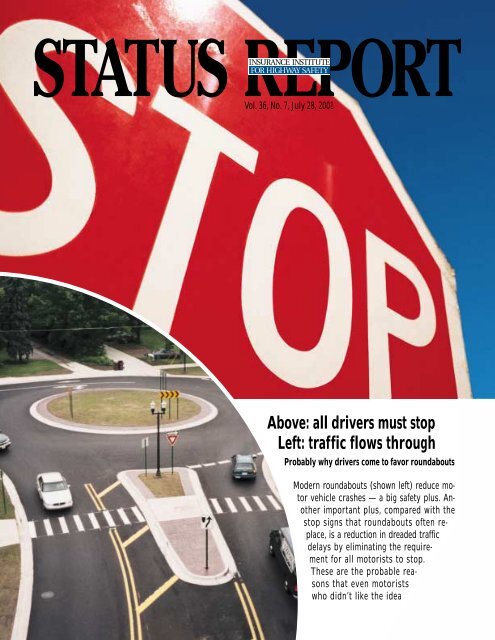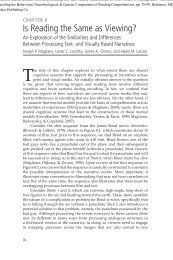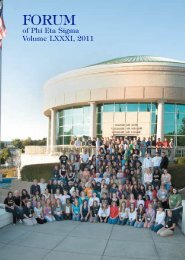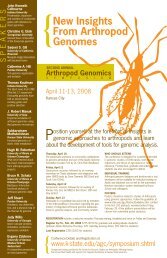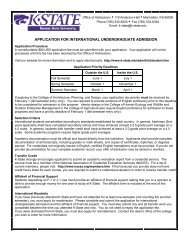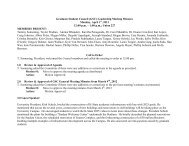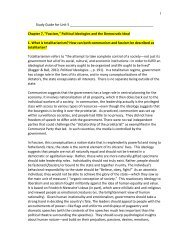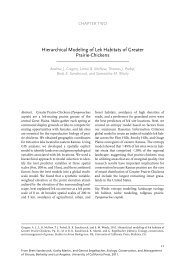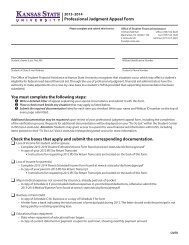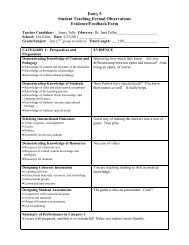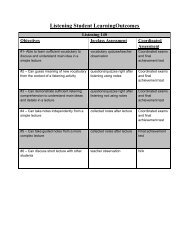Status Report, Vol. 36, No. 7, July 28, 2001 - Insurance Institute for ...
Status Report, Vol. 36, No. 7, July 28, 2001 - Insurance Institute for ...
Status Report, Vol. 36, No. 7, July 28, 2001 - Insurance Institute for ...
Create successful ePaper yourself
Turn your PDF publications into a flip-book with our unique Google optimized e-Paper software.
<strong>Vol</strong>. <strong>36</strong>, <strong>No</strong>. 7, <strong>July</strong> <strong>28</strong>, <strong>2001</strong><br />
Above: all drivers must stop<br />
Left: traffic flows through<br />
Probably why drivers come to favor roundabouts<br />
Modern roundabouts (shown left) reduce motor<br />
vehicle crashes — a big safety plus. Another<br />
important plus, compared with the<br />
stop signs that roundabouts often replace,<br />
is a reduction in dreaded traffic<br />
delays by eliminating the requirement<br />
<strong>for</strong> all motorists to stop.<br />
These are the probable reasons<br />
that even motorists<br />
who didn’t like the idea
2 <strong>Status</strong> <strong>Report</strong>, <strong>Vol</strong>. <strong>36</strong>, <strong>No</strong>. 7, <strong>July</strong> <strong>28</strong>, <strong>2001</strong><br />
of roundabouts to begin with end up liking them once they’re installed<br />
and drivers navigate them a few times.<br />
The finding that roundabouts reduce crashes, including injury<br />
crashes, isn’t new. An <strong>Institute</strong> study found a 75 percent reduction<br />
in injury crashes at roundabouts converted from stop signs or signals<br />
(see <strong>Status</strong> <strong>Report</strong>, May 13, 2000; on the web at www.highwaysafety.<br />
org). What’s new is that roundabouts also reduce delays<br />
at U.S. intersections. This is a main finding of a recent <strong>Institute</strong><br />
study conducted by researchers at Kansas State University, who<br />
measured traffic flow at three intersections in Kansas, Maryland,<br />
and Nevada be<strong>for</strong>e and after conversion to roundabouts.<br />
“In each case, installing a roundabout reduced the amount of<br />
traffic having to stop at the intersection, leading to about a 20 percent<br />
reduction in delays,” says Richard Retting, the <strong>Institute</strong>’s senior<br />
transportation engineer. The proportion of vehicles having to<br />
stop declined 14 to 37 percent across all three sites. In turn, backups<br />
on the approach streets declined at all three sites, and delays<br />
per vehicle dropped 13 to 23 percent.<br />
These improvements were found at intersections where roundabouts<br />
replaced stop signs — the main use of roundabouts so far<br />
in the United States. Other studies have found substantial traffic<br />
flow improvements at intersections where roundabouts replaced<br />
traffic signal lights.<br />
Reduced stopping means fewer traffic delays: “Stopping is<br />
the number one cause of delay at intersections, so when you eliminate<br />
the requirement to stop, you reduce delays,” Retting explains.<br />
“Because roundabouts keep most traffic moving, they can<br />
handle more traffic in the same amount of time compared with<br />
stop-controlled intersections. Traffic might only be moving at 15<br />
mph, but even with the reduced speeds it’s more efficient because<br />
you’re not requiring every vehicle to come to a complete stop.”<br />
A roundabout also improves access to intersections <strong>for</strong> motorists<br />
approaching from minor roads. This helps to reduce delays<br />
that can occur when volume is a lot heavier on some approaches<br />
than others. Stop signs and signals are less efficient because they<br />
require at least some traffic to stop. They’re also less safe.<br />
“The most serious kinds of crashes at conventional intersections<br />
are virtually eliminated by roundabouts,” Retting points out. “Crashes<br />
that do occur tend to be minor because traffic speeds are slower.”<br />
Experience changes opinions: Roundabouts still haven’t been<br />
as fully accepted in the United States as elsewhere. For example,<br />
they’re widespread in the United Kingdom and engineers in France<br />
are building upwards of 1,500 new roundabouts per year. Public resistance<br />
in the United States is part of the problem, but the resistance<br />
is expected to fade as more communities build roundabouts.<br />
Public opinion surveys conducted in the three communities show<br />
more than a doubling of support <strong>for</strong> roundabouts after they’re built.<br />
For a copy of “Public opinion and traffic flow impacts of newly<br />
installed modern roundabouts in the United States” by R.A. Retting<br />
et al. write: Publications, <strong>Insurance</strong> <strong>Institute</strong> <strong>for</strong> Highway Safety,<br />
1005 N. Glebe Rd., Arlington, VA 22201.<br />
Drivers may think the<br />
American motorists often say they don’t like<br />
roundabouts, but experience quickly wins them<br />
over. This is a main finding of a new survey conducted<br />
<strong>for</strong> the <strong>Institute</strong>. Twice as many drivers<br />
favor roundabouts after installation, compared<br />
with be<strong>for</strong>e.<br />
Researchers first surveyed drivers in three<br />
communities in Kansas, Maryland, and Nevada<br />
where roundabouts were to be constructed.<br />
Follow-up surveys conducted a few months after<br />
installation show opinions had changed dramatically.<br />
The proportion of drivers in favor doubled<br />
overall, from 31 percent be<strong>for</strong>e construction to<br />
63 percent after. Those who were strongly opposed<br />
dropped from 41 percent to 15 percent.<br />
Each time drivers were surveyed, those<br />
against roundabouts were asked the reasons <strong>for</strong><br />
their opposition. About one-third of opposed<br />
drivers in the first survey said they would prefer<br />
a new traffic signal or to keep the stop signs that<br />
were already in place. Another 40 percent cited<br />
concerns about safety or confusion at the new intersections.<br />
After the roundabouts were constructed,<br />
objections were similar but only half as<br />
many drivers were opposed.<br />
Be<strong>for</strong>e and after construction, drivers were<br />
asked about the impact of roundabouts on congestion<br />
and safety. Be<strong>for</strong>e construction, 27 percent<br />
of the drivers thought congestion would be<br />
reduced. After construction, 42 percent thought<br />
it had been reduced. About a third of the drivers
y won’t like roundabouts, but they end up being fans<br />
questioned be<strong>for</strong>e construction thought there would be a safety<br />
improvement, and the proportion increased to 50 percent after<br />
roundabouts were installed.<br />
“Many drivers simply prefer the traffic controls they’re more familiar<br />
with. There’s a natural resistance to the unknown,” says<br />
Richard Retting, the <strong>Institute</strong>’s senior transportation engineer. “Still,<br />
some of the concerns we heard are based on real misunderstandings.”<br />
For example, far from being unsafe roundabouts significantly<br />
reduce crashes (see <strong>Status</strong> <strong>Report</strong>, May 13, 2000; on the web at<br />
www.highwaysafety.org).<br />
Communication is important to overcome biases and build support<br />
<strong>for</strong> roundabouts be<strong>for</strong>e they’re operational, Retting also notes.<br />
But this only goes so far because, <strong>for</strong> many people, seeing is believing.<br />
Eugene Russell, professor at Kansas State University’s<br />
Department of Civil Engineering and a co-author of<br />
the study, says that “at first communities say, ‘We<br />
don’t want roundabouts here. We don’t need them<br />
just because England or France has them.’ But<br />
after the roundabouts are in, communities<br />
like them because they work.”<br />
This is what happened in University<br />
Place, the first city in Washington State<br />
to build a modern roundabout. Public<br />
works director Steve Sugg says a demonstration was important to<br />
secure wide support. “Initially we had to overcome strong public<br />
opposition,” he says. “To try something this new and innovative required<br />
a heck of a lot of public involvement — more than I had ever<br />
been exposed to in my career. But in the end, people came around,<br />
and all of that ef<strong>for</strong>t paid off. <strong>No</strong>w we have five roundabouts, and<br />
they’re actually a source of pride <strong>for</strong> the citizens in the community.”<br />
Percent reductions in traffic delays<br />
and stopped vehicles after roundabouts<br />
■ stopped vehicles<br />
-14%<br />
KANSAS<br />
-19%<br />
■ delays<br />
MARYLAND<br />
-23%<br />
NEVADA<br />
-13%<br />
-34%<br />
-37%<br />
Percent of drivers who favor and oppose<br />
roundabouts be<strong>for</strong>e and after construction<br />
■ be<strong>for</strong>e ■ after<br />
63%<br />
31%<br />
41%<br />
15%<br />
FAVOR<br />
STRONGLY OPPOSE
4 <strong>Status</strong> <strong>Report</strong>, <strong>Vol</strong>. <strong>36</strong>, <strong>No</strong>. 7, <strong>July</strong> <strong>28</strong>, <strong>2001</strong><br />
Special report<br />
Balanced approach<br />
to highway safety still<br />
isn’t appreciated by all<br />
<strong>No</strong>te: Until the 1960s, highway safety ef<strong>for</strong>ts<br />
focused almost exclusively on preventing<br />
crashes by changing driver behavior. Such<br />
ef<strong>for</strong>ts rarely were evaluated. A pioneer in<br />
the successful ef<strong>for</strong>t to introduce a balanced<br />
approach, underpinned by scientific evaluations,<br />
was William Haddon, Jr., M.D., head<br />
of the first federal highway safety agency<br />
(1967-69) and president of the <strong>Insurance</strong> <strong>Institute</strong><br />
<strong>for</strong> Highway Safety (1969-85). For the<br />
past 40 years or so, the field of highway<br />
safety has focused on loss reduction measures<br />
involving not only drivers but<br />
also vehicles and roads. Still,<br />
some people claim Haddon and<br />
others engineered an almost<br />
exclusive swing toward redesigning<br />
vehicles. They<br />
say driver measures began<br />
to be neglected,<br />
which hampered U.S.<br />
progress toward reducing<br />
crash deaths and injuries.<br />
This view was most recently<br />
propounded in a<br />
long magazine article by<br />
Malcolm Gladwell (“Wrong<br />
Turn,” The New Yorker, June<br />
11). The magazine publishes only<br />
short rebuttals, so <strong>Status</strong> <strong>Report</strong> offers<br />
the following response from <strong>Institute</strong><br />
president Brian O’Neill.<br />
According to Gladwell, highway<br />
safety policy in the United<br />
States took a “wrong turn” largely<br />
because it was influenced by<br />
William Haddon, Jr., who believed<br />
“that the best way to combat the<br />
epidemic on the highways was to<br />
shift attention from the driver to<br />
the vehicle.” Gladwell claims highway<br />
safety orthodoxy <strong>for</strong> much of<br />
the last century “held that safety<br />
was about reducing accidents —<br />
precrash<br />
crash<br />
postcrash<br />
educating drivers, training them, making<br />
them slow down. To Haddon this approach<br />
made no sense. His goal was to reduce the<br />
injuries that accidents caused. In particular,<br />
he did not believe in safety measures<br />
that depended on changing the behavior of<br />
the driver.”<br />
The first part of this claim is correct.<br />
Until the late 1960s, “orthodox” highway<br />
safety was only about preventing accidents.<br />
But the second part of the statement<br />
couldn’t be further from the truth.<br />
Haddon believed there should be a systematic<br />
and balanced approach including measures<br />
to prevent crashes, reduce injuries<br />
during crashes, and reduce the consequences<br />
after crashes.<br />
Haddon Matrix<br />
human<br />
vehicle<br />
Right: William Haddon, Jr., M.D.<br />
environment<br />
Today all students of injury control are<br />
familiar with the Haddon matrix, a tool to<br />
help systematically identify all options<br />
available to reduce injuries. Some of these<br />
options involve changing human behavior.<br />
Gladwell is correct that “Haddon believed<br />
the best safety measures were passive.”<br />
But Haddon didn’t believe these<br />
were the only measures that could be effective.<br />
He strongly advocated those that<br />
scientific research demonstrated were effective<br />
— and science (then and now)<br />
showed most of the orthodox approaches<br />
of the day didn’t work.<br />
The “wrong turn” the United States supposedly<br />
took was to pass legislation in the<br />
late 1960s authorizing the federal government<br />
to set safety standards <strong>for</strong> new cars.<br />
Most, but not all, such standards resulted
<strong>Status</strong> <strong>Report</strong>, <strong>Vol</strong>. <strong>36</strong>, <strong>No</strong>. 7, <strong>July</strong> <strong>28</strong>, <strong>2001</strong> 5<br />
in “passive” safety features in vehicles. But<br />
the standards also included requirements<br />
<strong>for</strong> active safety features such as lap/<br />
shoulder belts. The passive features that<br />
required no action on the part of occupants<br />
included energy-absorbing steering<br />
columns, laminated windshields, side door<br />
beams, etc. Such features have saved thousands<br />
of lives, as have federally mandated<br />
lap/shoulder belts.<br />
“<strong>No</strong> other country pursued the passive<br />
strategy as vigorously,” Gladwell claims.<br />
Yet a few years after the introduction of<br />
the first new vehicle safety standards<br />
in the United States during<br />
the late 1960s and early<br />
1970s, almost identical vehicle<br />
standards were adopted in Canada,<br />
Europe, and Australia.<br />
What Gladwell fails to mention is that at<br />
the same time the U.S. Congress passed<br />
the legislation that authorized federal vehicle<br />
safety standards, it passed companion<br />
legislation to establish standards <strong>for</strong> state<br />
highway safety programs. As head of the<br />
first federal highway safety bureau, Haddon<br />
issued 13 such standards that addressed<br />
issues including alcohol-impaired<br />
driving, driver licensing, and motorcycle<br />
helmet use. This was part of the balanced<br />
approach — addressing road users and vehicles<br />
— that Haddon strongly believed in.<br />
way safety programs. Today only 21 states<br />
have motorcycle helmet use laws.<br />
This one example illustrates why some<br />
other countries have been more successful<br />
than the United States in reducing some<br />
kinds of motor vehicle crash deaths and<br />
injuries. While U.S. states were repealing<br />
helmet use laws, other countries, which already<br />
had helmet laws, were adopting seat<br />
belt use laws. This was not because Haddon<br />
and his colleagues had no interest in<br />
such measures. In fact, Haddon endorsed<br />
seat belt use laws after research funded by<br />
Motorcycle helmet use was a focus of 1 of the 13 safety standards addressing road users<br />
that Haddon issued when he headed the federal highway safety bureau. Such standards<br />
were part of the balanced approach that Haddon strongly believed in.<br />
(Road design standards weren’t included<br />
only because they’re administered by a different<br />
federal agency.)<br />
One of the federal highway safety standards<br />
issued at Haddon’s behest required<br />
all states to adopt motorcycle helmet use<br />
laws. By the early 1970s, all but three<br />
states had such laws covering all riders.<br />
But then politicians in Cali<strong>for</strong>nia (one of<br />
the states without laws) challenged this requirement,<br />
and the challenge led to the<br />
demise of federal standards <strong>for</strong> state high-<br />
the <strong>Institute</strong> in 1972 demonstrated the effectiveness<br />
of the world’s first belt use law<br />
in Victoria, Australia. The erosion of effective<br />
highway safety programs aimed at<br />
road users occurred because state politicians<br />
refused to show leadership, not because<br />
of Haddon’s ideology.<br />
Gladwell correctly points out that in<br />
the 1970s many countries followed the<br />
lead of Victoria and adopted belt use laws.<br />
He then claims that “a similar movement in<br />
the United States in the early seventies
6 <strong>Status</strong> <strong>Report</strong>, <strong>Vol</strong>. <strong>36</strong>, <strong>No</strong>. 7, <strong>July</strong> <strong>28</strong>, <strong>2001</strong><br />
stalled...”. What movement is he referring<br />
to? In the 1970s many states were repealing<br />
motorcycle helmet use laws, which<br />
were proven to reduce motorcyclist<br />
deaths, but there was no movement to<br />
pass seat belt use laws as early as the<br />
1970s. Safety advocates including Haddon<br />
went on record in support of such laws.<br />
The federal government had some incentive<br />
grants available to any states that<br />
passed such laws. But there was no real<br />
movement and no progress toward seat<br />
belt use laws until the mid-1980s.<br />
It is absurd to claim that “if [Ralph]<br />
Nader had advocated mandatory belt laws<br />
they might have carried the day.” Does<br />
anyone believe politicians who voted to repeal<br />
helmet laws would have changed<br />
their minds and voted <strong>for</strong> seat belt laws<br />
because Nader asked them to?<br />
Even today, most states have weak belt<br />
laws with significant gaps in coverage, minimum<br />
penalties, and en<strong>for</strong>cement only if<br />
another traffic violation has been observed.<br />
Only a few jurisdictions have good<br />
laws and politicians who encourage ef<strong>for</strong>ts<br />
to get more motorists to buckle up.<br />
The contrast with other countries is obvious.<br />
In Canada, <strong>for</strong> example, belt use exceeds<br />
90 percent in all provinces, a rate<br />
achieved by good seat belt use laws together<br />
with well-publicized en<strong>for</strong>cement.<br />
In the United States belt use rates range<br />
from below 50 percent in <strong>No</strong>rth Dakota to<br />
about 90 percent in Cali<strong>for</strong>nia. Our generally<br />
dismal record with respect to belt use —<br />
compared with Canada, northern Europe,<br />
Australia, and a number of other countries<br />
— has nothing to do with a “wrong turn” in<br />
U.S. policy. It has to do with the failure of<br />
political leadership in many states.<br />
Most highway safety measures that can<br />
successfully change road user behavior are<br />
implemented at the state level. Since the<br />
mid-1970s the federal safety program has<br />
been able to do little more than encourage<br />
appropriate state action. The balanced<br />
program Haddon and others supported in<br />
the late 1960s envisaged a much more direct<br />
federal role. Setting aside issues of<br />
federal versus state responsibilities, the<br />
undeniable fact is that the original federal<br />
role would have resulted in more<br />
progress in highway safety than has<br />
been accomplished.<br />
“In 1959, Haddon [shown left] and I organized<br />
a conference, perhaps the first ever on<br />
As to Gladwell’s section on<br />
seat belts and airbags, he<br />
needs a lesson in restraint system<br />
per<strong>for</strong>mance and design. .... By the mid-nineteen-sixties, we had an<br />
automobile trauma as a public health issue<br />
He claims “that even today it agency with Haddon as its head. The issue had<br />
is seat belts, not airbags, that been correctly defined. This is what mattered,<br />
are providing the most impor- not the ups and downs that followed. Fifty years<br />
ago, cars didn’t have ‘crashes.’ Drivers had<br />
‘accidents.’ Haddon did this.” — Former<br />
U.S. Senator Daniel Patrick Moynihan, letter<br />
to The New Yorker, <strong>July</strong> 9, <strong>2001</strong><br />
tant new safety advances.” He apparently<br />
is unaware that belt pretensioners are only<br />
possible because they use the same technology<br />
as airbags. He doesn’t seem to be<br />
aware that belt <strong>for</strong>ce limiters, which allow<br />
belts to “pay out” extra webbing to reduce<br />
chest loads also are possible only with<br />
airbags. Without airbags, belt <strong>for</strong>ce limiters<br />
would allow drivers’ faces to strike<br />
the steering wheels in many crashes. Today<br />
all auto manufacturers are designing<br />
their seat belts and airbags to work together<br />
as a single system to optimize occupant<br />
protection in crashes.<br />
Finally, Gladwell describes<br />
a crash involving Robert Day<br />
and others, claiming Day’s<br />
“best chance” of surviving<br />
“would have been to wear his<br />
seat belt.” Day was in a side<br />
impact, during which Gladwell<br />
says “the door was<br />
driven into him like a sledgehammer.”<br />
This is a crash<br />
circumstance when a belt almost<br />
certainly would have<br />
provided no benefit. Day<br />
would have been much more<br />
likely to benefit from a side<br />
impact torso airbag and/or<br />
improved side vehicle structure — the<br />
kinds of technologies Gladwell dismisses.<br />
I had the privilege of working closely<br />
with Bill Haddon longer than perhaps anyone,<br />
from 1969 until his premature death in<br />
1985. Gladwell’s portrait is a distortion of<br />
the man and his views. The article fails to<br />
communicate the true scope of the original<br />
federal motor vehicle safety standards<br />
shepherded by Haddon. In addition, it<br />
hopelessly misrepresents the successful<br />
history of highway and motor vehicle safety<br />
ef<strong>for</strong>ts during the last three and half<br />
decades of the 20th century.
<strong>Status</strong> <strong>Report</strong>, <strong>Vol</strong>. <strong>36</strong>, <strong>No</strong>. 7, <strong>July</strong> <strong>28</strong>, <strong>2001</strong> 7<br />
More conspicuous<br />
trucks are less likely<br />
to be hit in side or rear,<br />
federal study shows<br />
Red and white retroreflective tape has significantly<br />
reduced impacts into the sides<br />
and rears of truck trailers. A new study<br />
from the National Highway Traffic Safety<br />
Administration (NHTSA)<br />
indicates these treatments<br />
are most effective<br />
on roadways that are<br />
dark and unlighted.<br />
For the study, the<br />
Florida Highway Patrol<br />
and Pennsylvania State<br />
Police collected 1997-99<br />
data on crashes involving<br />
tractor-trailers, noting<br />
whether or not retroreflective<br />
tape had been<br />
applied to enhance conspicuity.<br />
Crashes were<br />
grouped according to<br />
whether they might have<br />
been prevented by improved<br />
conspicuity or<br />
whether they couldn’t<br />
possibly have been affected<br />
by the conspicuity<br />
treatment. The first group<br />
of collisions included, <strong>for</strong><br />
example, those involving<br />
cars striking the sides of<br />
truck trailers. The second<br />
group of crashes includ-<br />
ed tractor-trailers that ran off the road or<br />
other vehicles crashing into the fronts of<br />
truck rigs.<br />
Conspicuity-relevant crashes were compared<br />
among trailers with and without<br />
retroreflective tape. The researchers analyzed<br />
crash results <strong>for</strong> various conditions<br />
including dark-not-lighted, dark-lighted,<br />
dawn, dusk, and daylight. The tape is most<br />
effective in dark, unlighted conditions.<br />
In Florida, the tape reduced crashes into<br />
the rears and sides of trailers by 37 percent<br />
in dark-not-lighted conditions, com-<br />
pared with trailers that hadn’t been treated<br />
with retroreflective tape. In Pennsylvania,<br />
the reduction in crashes amounted to<br />
44 percent.<br />
While the original rule applied only to<br />
trailers manufactured after December 1,<br />
1993, the conspicuity requirement was extended<br />
in 1999 to the entire on-road trailer<br />
fleet, effective June 1, <strong>2001</strong>. Tractors made<br />
after <strong>July</strong> 1, 1997 also must be treated.<br />
ments to single-unit trucks. There are nearly<br />
5.8 million of them on the road, and a<br />
substantial number operate during hours<br />
of darkness.”<br />
Braver adds that improved rear underride<br />
guards also would help prevent injuries.<br />
“Retroreflective tape can prevent<br />
some crashes into the rears of single-unit<br />
trucks. But in the absence of adequate rear<br />
underride guards, there’s still a major haz-<br />
Researchers analyzed the crash involvement of truck rigs with and without reflective treatments in various<br />
light conditions (dark-not-lighted, dark-lighted, dawn, dusk, and daylight), finding that retroreflective tape<br />
is most effective in dark conditions with no lighting.<br />
PHOTO COURTESY 3M<br />
But an important gap remains. NHTSA<br />
doesn’t require treatment <strong>for</strong> single-unit<br />
trucks (as opposed to tractor-trailers),<br />
pointing out that the single units are less<br />
frequently operated at night and they’re involved<br />
in fewer fatal crashes — about 25<br />
percent of fatal large truck crashes.<br />
“Still, single-unit trucks are involved in<br />
about 45 percent of injury-producing large<br />
truck crashes,” notes <strong>Institute</strong> senior researcher<br />
Elisa Braver. “The NHTSA study<br />
results should prompt the agency to examine<br />
whether to extend conspicuity requireard<br />
to people riding in passenger vehicles<br />
that strike the rears of these trucks, many<br />
of which sit high off the ground.” Improved<br />
underride guards were required on trailers<br />
in 1998, but they aren’t yet required on<br />
single-unit trucks.<br />
“The effectiveness of retroreflective<br />
tape on heavy trailers” (DOT HS 809 222)<br />
by Christina Morgan is available from the<br />
National Technical In<strong>for</strong>mation Service,<br />
Springfield, VA 22161. Or visit the NHTSA<br />
website: www.nhtsa.dot.gov/cars/rules/regrev/evaluate/809222.html.
STATUS REPORT<br />
NON-PROFIT ORG.<br />
U.S. POSTAGE<br />
PAID<br />
PERMIT NO. 252<br />
ARLINGTON, VA<br />
1005 N. Glebe Rd., Arlington, VA 22201<br />
703/247-1500 Fax 247-1588<br />
Internet: www.highwaysafety.org<br />
<strong>Vol</strong>. <strong>36</strong>, <strong>No</strong>. 7, <strong>July</strong> <strong>28</strong>, <strong>2001</strong><br />
Roundabouts reduce traffic backups as<br />
well as crashes involving injuries ...........p.1<br />
Motorists’ acceptance of roundabouts increases<br />
with experience ...........................p.2<br />
Special report: After William Haddon’s<br />
balanced approach to highway safety is<br />
misrepresented in The New Yorker, Brian<br />
O’Neill sets the record straight .................p.4<br />
Reflective tape on trucks reduces crashes<br />
into the sides and rears of trailers ..........p.7<br />
Contents may be republished with attribution.<br />
This publication is printed on recycled paper.<br />
ISSN 0018-988X<br />
The <strong>Insurance</strong> <strong>Institute</strong> <strong>for</strong> Highway Safety<br />
is an independent, nonprofit, scientific and<br />
educational organization dedicated to reducing<br />
the losses — deaths, injuries, and<br />
property damage — from crashes on the nation’s<br />
highways. The <strong>Institute</strong> is wholly supported<br />
by automobile insurers:<br />
Alfa <strong>Insurance</strong><br />
Allstate <strong>Insurance</strong> Group<br />
American Express Property and Casualty<br />
American Family <strong>Insurance</strong><br />
American National Property and Casualty<br />
Amica Mutual <strong>Insurance</strong> Company<br />
Amwest <strong>Insurance</strong> Group<br />
Auto Club South <strong>Insurance</strong> Company<br />
Automobile Club of Michigan Group<br />
Baldwin & Lyons Group<br />
Bituminous <strong>Insurance</strong> Companies<br />
Brotherhood Mutual<br />
Cali<strong>for</strong>nia <strong>Insurance</strong> Group<br />
Cali<strong>for</strong>nia State Automobile Association<br />
Chubb Group of <strong>Insurance</strong> Companies<br />
Church Mutual<br />
Colonial Penn<br />
Concord Group <strong>Insurance</strong> Companies<br />
Cotton States<br />
Country <strong>Insurance</strong> & Financial Services<br />
Erie <strong>Insurance</strong> Group<br />
Farmers <strong>Insurance</strong> Group of Companies<br />
Farmers Mutual of Nebraska<br />
Fidelity & Deposit<br />
Foundation Reserve <strong>Insurance</strong> Company<br />
Frankenmuth<br />
The GEICO Group<br />
General Casualty <strong>Insurance</strong> Companies<br />
General Electric Financial Assurance<br />
GMAC <strong>Insurance</strong> Group<br />
Grange <strong>Insurance</strong><br />
Harleysville <strong>Insurance</strong> Companies<br />
The Hart<strong>for</strong>d<br />
Idaho Farm Bureau<br />
Instant Auto <strong>Insurance</strong><br />
Kansas Farm Bureau<br />
Kemper <strong>Insurance</strong> Companies<br />
Liberty Mutual <strong>Insurance</strong> Group<br />
Merastar<br />
Mercury General Group<br />
MetLife Auto & Home<br />
Middlesex Mutual<br />
Montgomery <strong>Insurance</strong> Companies<br />
Motor Club of America <strong>Insurance</strong> Company<br />
Motorists <strong>Insurance</strong> Companies<br />
MSI <strong>Insurance</strong> Companies<br />
National Grange Mutual<br />
Nationwide <strong>Insurance</strong><br />
<strong>No</strong>rth Carolina Farm Bureau<br />
<strong>No</strong>rthland <strong>Insurance</strong> Companies<br />
Oklahoma Farm Bureau<br />
Old Guard <strong>Insurance</strong><br />
OneBeacon <strong>Insurance</strong><br />
Oregon Mutual Group<br />
OrionAuto<br />
Palisades Safety and <strong>Insurance</strong> Association<br />
Pekin <strong>Insurance</strong><br />
PEMCO <strong>Insurance</strong> Companies<br />
The Progressive Corporation<br />
The Prudential<br />
Response <strong>Insurance</strong><br />
Rockingham Group<br />
Royal & SunAlliance<br />
SAFECO Corporation<br />
SECURA<br />
Shelter <strong>Insurance</strong> Companies<br />
State Auto <strong>Insurance</strong> Companies<br />
State Farm <strong>Insurance</strong> Companies<br />
The St. Paul Companies<br />
Tokio Marine<br />
USAA<br />
Virginia Farm Bureau<br />
Virginia Mutual <strong>Insurance</strong> Company<br />
Yasuda Fire & Marine of America<br />
Zurich <strong>No</strong>rth America


